Growling Grass Frog
Growling Grass FrogLitoria raniformis | |
|---|---|
| Kingdom: | Animalia |
| Phylum: | Chordata |
| Class: | Amphibia |
| Order: | Anura |
| Family: | Hylidae |
| Status | |
| World: | Vulnerable (IUCN Red List 2025) |
| Australia: | Vulnerable (EPBC Act listed) |
| Victoria: | Vulnerable (FFG threatened List 2025) |
| Vic FFG: | Action Statement |
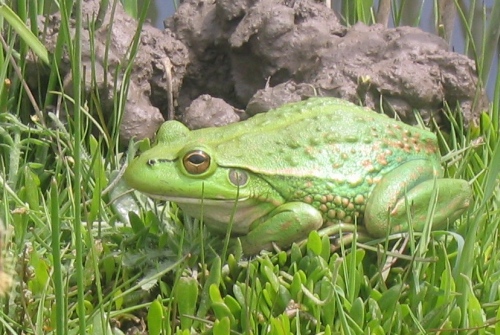
The Growling Grass Frog Litoria raniformis, also known as the Southern Bell Frog or Warty Bell Frog is distributed across south-eastern Australia, being found in New South Wales (Riverina area), Victoria, Tasmania and south-eastern South Australia. It is a large diurnal frog that was common and widespread across its range but declined quite suddenly from about 1990 and is now uncommon and threatened. It was listed as a threatened species under the Victorian Flora and Fauna Guarantee Act 1988 in 2001, and declared endangered in 2002 due to a significant decline across much of its range. The conservation status was changed from endangered to vulnerable as part of the Conservation Status Assessment Project in 2020, it is now considered Vulnerable (FFG Threatened list 2025).
Isolated populations still occur in the greater Melbourne area and across areas in south western Victoria.
Genetic research has found two sub-species of Growling Grass Frog exist:
- Litoria raniformis raniformis - (northern sub-species occuring in the Murray-Darling Basin)
- Litoria raniformis major - (southern sub-species occuring in south-eastern South Australia, southern and south-eastern Victoria and Tasmania.
(Voros et al. 2013)
Distinguishing features are bright to olive-green colour, warty back (with brown blotches in the adult), dorso-lateral fold, and distinct tympanum (ear).
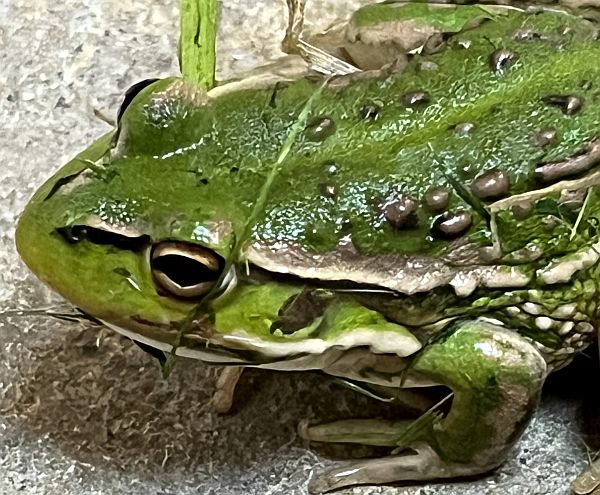
Distribution
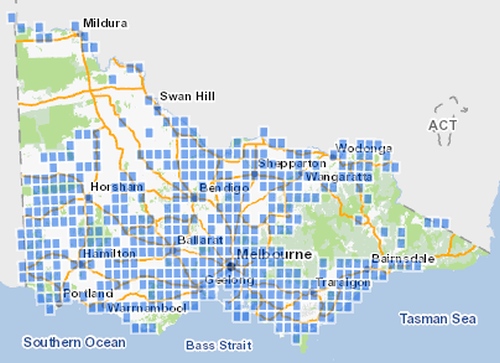
All known historic records of Growling Grass Frog in Victoria. Source: Victorian Biodiversity Atlas, Department of Environment,Water, Land and Planning, Accessed 29 July 2015.
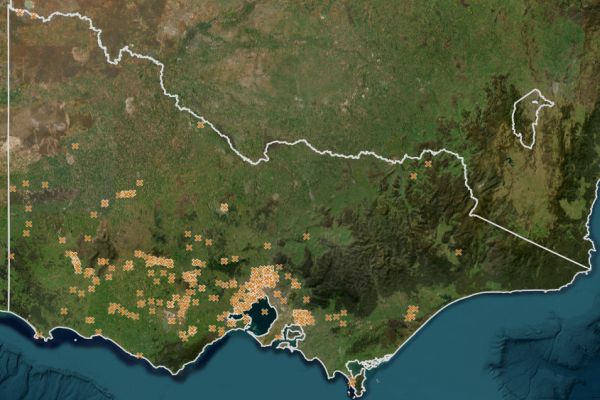
Ecology & Habitat
The Growling Grass Frog needs still or slow moving water with emergent vegetation around the edges and mats of floating and submerged plants. They can live in artificial waterbodies, such as farm dams, irrigation channels and disused quarries. Favourable habitat features include abundant aquatic vegetation, minimal tree canopy cover, waterbodies with salinity less than 7.0 mS/cm or (7000 EC) which hold water for at least six months of the year. A cluster of waterbodies (within 700 m) allows frogs to move between sites as conditions change. They usually move on rainy nights.
Typical aquatic vegetation comprising one or more species which may be found at Growling Grass Frog sites.
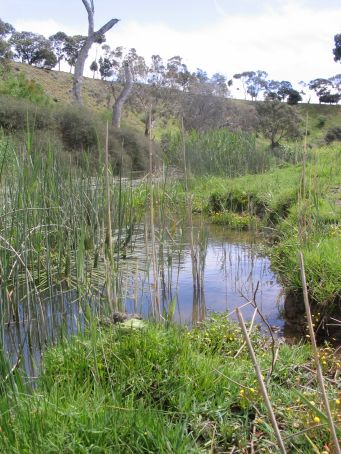 |
- Pondweed (Potamogeton tricarinatus)
- Cumbungi (Typha orientalis)
- Running Marsh Flower (Villarsia reniformis)
- Swamp Crassula (Crassula helmsii)
- Water Ribbons (Triglochin procerum)
- Common Reed (Phragmites australis)
- Water Couch (Paspalum distichum)
- Common Rush (Juncus usitatus)
- Common Spike Rush (Eleocharis acuta)
- Ribbon Weed (Vallisneria gigantea)
- Common Milfoil (Myriophyllum papillosum)
A major factor appears to be a combination of vegetation types in each site:
- Tall emergent (eg. Spike Rush) vegetation gives protection to the adult frogs from predators.
- Floating attached (eg. Running Marshflower) vegetation protects the tadpoles.
- Submerged and emergent vegetation, as well as feathery and non-feathery (eg. Swamp Crassula and Pondweed) vegetation types supply egg laying sites plus protection for the tadpoles in the tangled submerged growth.
Grass and shrub cover on the banks is also important for the emerging froglets to gain protection from predators and to acquire insect prey as a food source. The Growling Grass Frog has been recorded 200 metres from water, so they will readily migrate from a drying site to a stable site with suitable habitat. This species inhabits a wide variety of habitats from wet to very dry and this needs to be taken into account when decisions are being made relating to their survival.
Breeding
Breeding begins in August when calling males begin being able to attract females, although females usually don't begin to lay eggs until October – November.
Males will continue calling until the end of March but females don't usually respond unless the season is very wet and warm.
Eggs are laid in spring so the frogs need water that lasts over the summer for their tadpoles to develop. Females lay up to 4000 eggs in floating, foamy jelly rafts which sinks into submerged vegetation within twelve hours.
Tadpoles develop from the same spawn over a wide time frame.The tadpole stage can lasts 3-15 months and they may grow to 110 mm in total length. Some are fully developed and emerge from the water at 16 weeks, but they have been known to take up to 12 to 15 months to complete metamorphosis in Tasmania. In Victoria most tadpoles have emerged as frogs by the end of May.
The hatching of tadpoles depends on water temperature. 18 to 24 degrees Celsius is the optimum temperature and 24 - 36 hours appears to be the normal duration over which hatching occurs. It may take up to five days in lower temperature conditions.
The large pinkish grey tadpoles have yellowish fins and hide in aquatic vegetation or move to deeper water if disturbed. They develop the green/gold colouring towards the end of the tadpole stage.
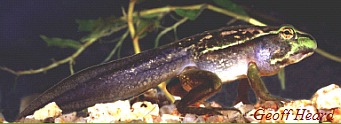
Feeding
The Growling Grass Frog is active in the warmer months of the year (September to March) and likes to bask in the sun on mild, sunny days. Like most frogs they usually call, feed and move around after dark. The Growling Grass Frog eats a wide range of insects and even small lizards, fish, tadpoles and frogs. It is a ‘sit-and-wait’ predator.
During winter these frogs are largely inactive and shelter on the land under rocks, logs, thick vegetation, or in ground crevices, often a long way from waterbodies and sometimes communally.
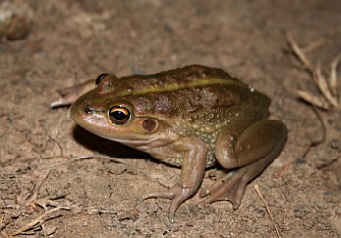
Source: Dams to Habitat project
Threats
Habitat loss
- Draining or filling of waterbodies.
- Barriers to movement between waterbodies.
- Lowing of freshwater groundwater through pumping.
- Increased salinity from run-off and altered hydrological systems.
- Reduced habitat quality because of changes to flow/filling, water quality/salinity, pollution and pesticide/herbicide use and increased nutrients.
- Elevated nitrate and phosphate concentrations have been identified as a impact. Historical and experimental evidence suggests that in New South Wales the decline of the Green and Golden Bell Frog L. aurea in its former range was due to high nutrient run off events. Fertilizers may also increase the nutrient status of waterbodies and thereby initiate eutrophication, resulting in lowered dissolved oxygen levels that do not support tadpoles (Hamer et al 2004).
- Loss of terrestrial habitat (used by frogs for shelter, movement or over-wintering) lost or damaged by stock grazing, land clearing, destruction/removal of rocks or logs.
Observations from dams with enhancement works as part of the 'Dams to Habitat' project found high density grazing, particularly from cattle, can have a significant impact on the ability of aquatic vegetation to establish and flourish at a site. The heavy grazing pressure, combined with trampling and higher turbidity levels can destroy young plants and severely reduce vegetation cover even if plants are well established.
Chytridiomycosis disease
Chytridiomycosis is an emerging infectious disease of frogs skin caused by the chytrid fungus, Batrachochytrium dendrobatidis and has been linked with continuing amphibian population declines in the western USA, Central America, Europe, Africa, and Australia. Ongoing studies suggest a correlation between resistance to lethal infection by B. dendrobatidis and synthesis (production) of antimicrobial peptides by the host amphibian. Further research is needed to define better the role of antimicrobial peptides in protection of amphibian populations and the effect of environmental factors upon antimicrobial peptide synthesis (Rollins-Smith & Conlon 2005).
Introduced fish
Predator species such as the introduced Mosquitofish Gambusia affinis can impact on tadpoles, Mosquitofish are prolific breeders producing offspring three or four times per year. They can tolerate poor water quality and can inhabit waters otherwise unsuitable to many of the native freshwater fishes, which increases their capacity to prey on tadpoles.
Climate change
As a basking species Growling Grass Frog,may be damaged by higher ultraviolet-B radiation levels caused by atmospheric ozone depletion.
The effects of all the above threats can be increased by drought or climatic change.
Conservation & Management in Victoria
Objectives
- Manage currently known and subsequently discovered populations for short-term protection from major threatening processes.
- Maintain and enhance the size of populations
- Improve knowledge and understanding of the Growling Grass Frog biology and ecology, including the role and importance of individual threats.
- Implement survey and monitoring programs to obtain essential demographic data.
- Increase community awareness of the conservation and management of the item
Specific conservation actions in Victoria
These actions are primarily lead by Department of Energy, Environment and Climate Action (DEECA) in conjunction with Catchment Management Authorities.
- Conduct surveys using recognised survey techniques to determine extent and abundance of populations of the species across all regions of Victoria.
- Ensure that actions specified in the Action Statement are included in the relevant Regional Catchment Strategies and Biodiversity Action Plans.
- Explore the possibility and desirability of undertaking control operations/threat abatement strategies against introduced predators of frogs and/or tadpoles, notably the exotic mosquito fish Gambusia.
- Promotion of conservation management networks for implementation of desired management actions for identified high-priority clusters of sites.
- Complete FFG Action Statement.
- Ensure that specified actions in the Action Statement are incorporated into park and reserve management plans.
- Undertake long-term monitoring of populations at selected sites throughout the range of the species
- Develop guidelines and implementation plans for reintroduction and translocation of Growling Grass Frogs subject to the recommendations of the Action Statement.
Projects & Partnerships
Dams to Habitat project
This project comenced in 2007/08 and was set up to provide simple management actions that can be used to create more viable habitat for the Growling Grass Frog, particularly during times of prolonged drought and climate change. Up until 2013 (5 years of surveys) 30 clusters totalling over 220 dams were surveyed across the Glenelg Hopkns, Corangamite and Wimmera CMA's with Growling Grass Frogs detected at 27 clusters.
Summary of findings
- Enhancing dams to provide breeding habitat for Growling Grass Frogs is possible using the projects methods, however, success is not guaranteed.
- Where aquatic vegetation increases at a dam, with or without assistance, Growling Grass Frogs may move in and even breed.
- Frogs will be encountered in dams that have very little or no vegetation. How long they stay in these dams is unknown and they are unlikely to breed in these dams.
- Enhancing dams to create habitat that is suitable for breeding by Growling Grass Frogs can be very difficult and costly and its success is dependent on a wide range of factors, many of which are not easy to control.
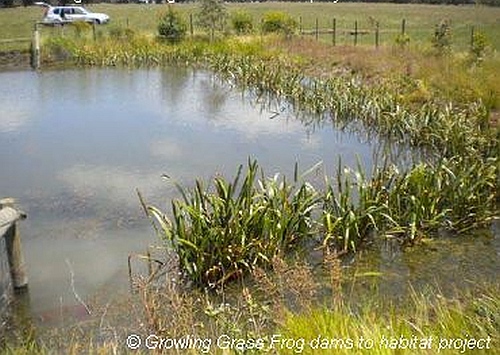
Farm dam 2 years after conservation works to establish Growling Grass Frog habitat.
The project will now focus on continuing the monitoring of already established dams in order to:
a) learn more about how the planted vegetation is improving frog habitat and how long it takes before dams become suitable for frogs and
b) learn more about the Growling Grass Frog ‘occupancy patterns’ at the treatment and control dams and assess where breeding occurs in order to better understand what influences breeding success in farm dams.
Full report: Nicholson, E., Bryant, D., Peterson, G. and Papas, P. (2013) Growling Grass Frog ‘Dams to Habitat’ Project Progress Report 2013. Unpublished Report. Department of Environment and Primary Industries, Heywood, Victoria. Growling Grass Frog ‘Dams to Habitat’ 2013 report
Nature Glenelg Trust wetalnd restoration
Nature Glenelg Trust is involved with restoration of previously drained wetlands on both public and private land in western Victoria. Key project locations include Glenshera Swamp restoration, Green Swamp restoration Reserve, Hutt Bay Wetland, Long Swamp restoration, Mount Burr Swamp Habitat restoration, Rowan Swamp restoration trial and Walker Swamp wetland restoration.
As a result of the wet season in 2022, wetlands filled, creating new habitat for the Growling Grass Frog with increased numbers being recorded in surveys.
Nature Glenelg Trust wetland restoration projects update 2022
Restoring wetlands in Victoria's south west - SWIFFT Seminar Notes 31 October 2014
Research
A sampling methodology and intensity required for surveys of the Growling Grass Frog has been completed and should be applied to all future studies. (Heard, Robertson and Scroggie 2006) and ARI Technical Report 208.
It is proposed that predator - prey interactions of exotic fish (especially introduced Mosquitofish) with Growling Grass Frog populations be studied and how these interactions affect habitat quality. Also contribute to and monitor the implications of broader research into control methods for Mosquitofish.
Research papers
- Metapopulation modelling has been conducted by Dr Geoff Heard (University of Melbourne). A Bayesian model of metapopulation viability, with application to an endangered amphibian 2013.
- Refugia and connectivity sustain amphibian metapopulations afflicted by disease.
- Characteristics of refugia used by the threatened Australian growling grass frog (Litoria raniformis) during a prolonged drought.
- Guidelines for managing the endangered. Growling Grass Frog in urbanising landscapes ARI Technical Report 208. (pdf)
- Assessing detection probabilities for the endangered growling grass frog (Litoria raniformis) in southern Victoria.
- Molecular systematic analysis demonstrates that the threatened southern bell frog, Litoria raniformis (Anura: Pelodryadidae) of eastern Australia, comprises two sub-species, Zootaxa 11 January 2023
References & Links
- FFG Threatened list (2025) Flora and Fauna Guarantee Act 1988 - Threatened List - March 2025 Department of Energy, Environment and Climate Action (DEECA).
- Hamer, A. J., Makings, A., Lane, S. J., Mahony, M. J. (2004) Amphibian decline and fertilizers used on agricultural land in south-eastern Australia, Agriculture, Ecosystems & Environment, Vol.102 (3) May 2004:299-305.
- IUCN (2025) IUCN SSC Amphibian Specialist Group. 2023. Litoria raniformis. The IUCN Red List of Threatened Species 2023: https://dx.doi.org/10.2305/IUCN.UK.2023-1.RLTS.T12152A78435466.en. Accessed on 22 April 2025.
- Rollins-Smith, L. A. & Conlon, M. J. (2005) Antimicrobial peptide defenses against chytridiomycosis an emerging infectious disease of amphibian populations, Developmental & Comparative Immunology, Vol. 29, Issue 7, 2005:589-598.
-
Voros, J., Wassens, S., Price, L., Hunter, D., Myers, S., Armstrong, A., Mahony, M., Donnellan, S. (2013) Molecular systematic analysis demonstrates that the threatened southern bell frog, Litoria raniformis (Anura: Pelodryadidae) of eastern Australia, comprises two sub-species Zootaxa DOI: 10.11646/ZOOTAXA.5228.1.1 Published 11/01/2023
- Growling Grass Frog (Southern Bell Frog) National Recovery Plan 2012 DEH species profile Litoria raniformis
- Frogs of Victoria web site – species Growling Grass Frog
- Frogs Australia Network – species Growling Grass Frog
- SWIFFT meeting notes 27 January 2011 Amphibian Ecology
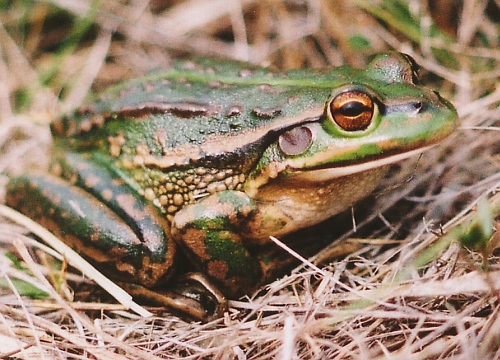
Please contribute information regarding Growling Grass Frog in Victoria - observations, images or projects. Contact SWIFFT

